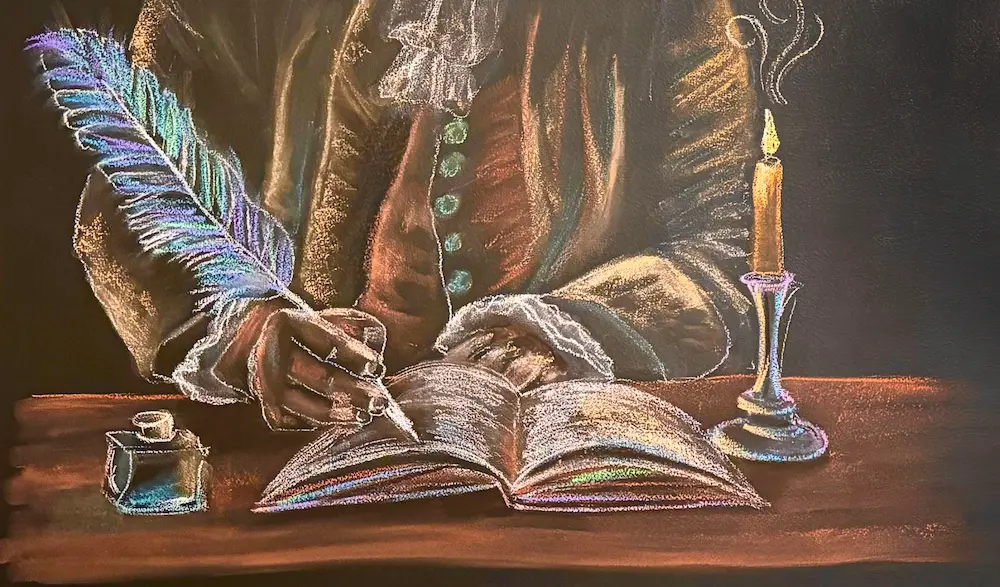When we consider how to teach creative writing to youth, we have to think of the overall process. We should consider what skills we are cultivating and in what order. Never should we do this haphazardly, but we should model it after the human being, itself. We can compose our methodology on the sacred geometry of the human soul, and thereby achieve maximum efficacy in our teaching.
The human being is composed of three soul forces: willing, feeling, and thinking. Without going into a lengthy explanation, the will involves our senses, our limbs, and our activity out in the world. It reaches into physical reality, sensing and affecting it directly. The will has no protection from the world in the same way our limbs are fully exposed. Its function is to work for us. On the opposite pole there is thinking. It is withdrawn form the world like a philosopher in his study, in the same way our brain is fully encapsulated in the cave of our skull. Its function is to contemplate, understand, and come up with new ideas.
Feeling stands between willing and thinking. It is a mix of the two, just as the heart and lungs are partially exposed and partially protected in the ribcage. Feeling operates in a rhythmic way, just like the waves of the ocean. It helps us decide what something means to us. It also helps us form judgments about the world in the same way lady justice weighs things on her balance-scale.
The Will of How to Teach Creative Writing
In Discussions with Teachers, Rudolf Steiner says, “People in general remember very little of what actually happens to them, and what they reproduce is mostly invention.” (Steiner, Rudolf. Discussions with Teachers. GA 295. Conference 3, 25 August 1919. Rudolf Steiner Press, 1997, pp. 23–24.) This bold point is especially important. People these days are prone to laziness of observation, a fact verified by a slew of studies.
When considering how to teach creative writing, therefore, we have to start with cultivating good observation skills. After all, sound creativity begins with a sound apprehension of reality. (This is all the more important since the images we give children are given stay with them for life.)
In a creative writing curriculum, therefore, we have to start with cultivating accurate observation, recollection, and description. The verbal portrait is a good example of this where we ask students to observe something or something. Then, we ask them to paint a picture of it with words like colors. In the process, we have them consider how many different ways they can say the same thing. For example, how many adjectives can you use to describe freshly baked bread? All these things help us to build the muscles of creative writing, just as you build the muscles of your arms and legs.
The Feeling of How to Teach Creative Writing
Whereas the first phase was like athletic training for the will, the second phase is to develop the students ability for the rhythm and artistry of language. This works especially with the heart and lung forces of feeling – the breathing process. Here, we work with rhythm and meter, both ancient and modern. We give the students a feel for both how language developed and where it is now.
Ancient Greece shall be our starting point with the dactylic hexameter of The Odyssey. (We do this in both Greek and English, lighting up the students’ feeling for how heart and breath infuse language with life.) We then proceed to the Old English-Germanic element of alliteration, another example of heartbeat and breath meeting language. Continuing in time, we play with the Middle English of Chaucer, when iambic pentameter came into common usage. Then, we come into the modern era start with Shakespeare, Milton, and many others.
Just as we build the will of creative writing, we build the feeling aspect. Students learn how to think and write rhythmically, enhancing their artistic process by leaps and bounds.
The Thinking of How to Teach Creative Writing
If you focus on the content of creative writing too early, you risk a weak foundation. This can lead to students losing interest since the skills are not there to sustain the creative process. It would be like a professional baseball player who doesn’t like strength training. He wants to hit homeruns, but he can only do it so often because the capacity isn’t there.
In the process of how to teach creative writing, however, once we have built a firm foundation of accurate observation and description, then rhythm and artistry with language, we can move into focusing on content. This is where the thinking element of planning plots and characters comes in. Here, students can conceptualize the transformations their stories will tell, and they will have the “muscles” and artistry to do it beautifully.
How we can help you
Enkindle Academy is offering a Creative Writing for Youth class stating October 3, 2025. Although, students are welcome to join this ongoing class anytime, since we will go through the process and then go through it again and again and again. Repetition builds the skills over time.
Enkindle Academy also offers academic prerecorded and live lessons for students in grades 5-9. We teach all academic subjects plus fine arts, creative writing, and empowerment groups for teens. We also offer 1-on-1 tutoring on all subjects including fine arts. Visit our website for more info and for free sample lessons, and remember to subscribe for weekly updates, tips for homeschooling, and special offers.


Leave a Reply
You must be logged in to post a comment.